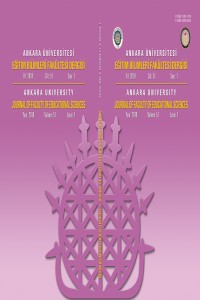Dezavantajlı Öğrencilerin Fen Okuryazarlık Performanslarının Duyuşsal Özellikleriyle İlişkisinin İncelenmesi
Öz
Bu araştırmada PISA 2015 kapsamında dezavantajlı öğrencilerin karakteristik
özellikleri ile ilgili hangi değişkenlerin fen performanslarını anlamlı bir
şekilde yordadığı incelenmiştir. Araştırma kapsamında PISA 2015 uygulamasından
elde edilen Türkiye verileri kullanılmıştır. Araştırmada bağımlı değişken
olarak PISA 2015 uygulamasında her bir öğrenci için hesaplanmış olan 10 farklı
olası başarı puanı (plausible values), bağımsız değişken olarak ise
öğrencilerin fen öğrenme motivasyonları, fen konularına ilgileri, fen öğrenmeye
araçsal güdülenmeleri ve fen öz yeterliği değişkenleri seçilmiştir. Araştırma
problemlerine cevap bulmak üzere yapılan Çoklu Regresyon analizi sonuçlarına
göre, belirlenen duyuşsal özelliklerin öğrencilerin fen okuryazarlık
performanslarını açıklama düzeyi dezavantajlı öğrencilerde % 6, dezavantajlı
olmayan öğrencilerde ise % 11 olarak bulunmuştur.
Anahtar Kelimeler
PISA 2015 fen okuryazarlığı dezavantajlı öğrenciler duyuşsal özellikler
Kaynakça
- American Association for the Advancement of Science (AAAS). (1995). Benchmarks for Science Literacy. New York: Oxford University Press.
- Bybee, R., Fensham, P., and Laurie, R. (2009). Scientific literacy and contexts in PISA 2006 science. Journal of Research in Science Teaching, 46(8), 862-864.
- Harlen, W. (2006). Teaching, Learning and Assessing Science 5-12. London: Sage Publications.
- Hobson, A. (2006). Science Literacy and Backward Priorities, The Physics Teacher, 44, 488–489.
- Hodson, D. (1992). In Search Of A Meaningful Relationship: An Exploration Of Some Issues Relating To Integration In Science And Science Education. International Journal of Science Education, 14(5), 541-562.
- Hodson, D. (1998) Science fiction: the continuing misrepresentation of science in the school curriculum, Curriculum Studies, 6(2), 191-216. doi: 10.1080/14681369800200033.
- International Association for the Evaluation of Educational Achievement (IEA). (2013). IDB Analyzer (Computer software and manual). Hamburg, Germany: IEA.
- Krapp, A. and M. Prenzel (2011), “Research on interest in science: Theories, methods, and findings”, International Journal of Science Education, 33(1), 27-50, http://dx.doi.org/10.1080/09500693.2010.518645.
- Laugksch, R. C. (2000). Scientific Literacy: A Conceptual Overview. Science Education, 84(1), 71–94.
- Mason, L. et al. (2012). Besides knowledge: A cross-sectional study on the relations between epistemic beliefs, achievement goals, self-beliefs, and achievement in science, Instructional Science, 41(1), 49–79. http://dx.doi.org/10.1007/s11251-012-9210-0.
- Milli Eğitim Bakanlığı[MEB], (2016). PISA 2015 Ulusal Raporu. Millî Eğitim Bakanlığı, Ölçme, Değerlendirme ve Sınav Hizmetleri Genel Müdürlüğü, Ankara.
- Milli Eğitim Bakanlığı[MEB], (2017). Fen Bilimleri Dersi Öğretim Programı (İlkokul ve Ortaokul 3, 4, 5, 6, 7 ve 8. Sınıflar). Ankara: Devlet.
- McLeod, D. B. (1992). Research on affect in mathematics education: A reconceptualization. Handbook of research on mathematics teaching and learning, 575-596.
- NRC (2007). Taking science to school: Learning and teaching science in grades K-8. Washington, DC: National Academy Press. http://www.nap.edu/catalog/11625.html
- Nugent, G., Barker, B., Welch, G., Grandgenett, N., Wu, C. and Nelson, C. (2015) A model of factors contributing to stem learning and career orientation, International Journal of Science Education, 37(7), 1067-1088, DOI: 10.1080/09500693.2015.1017863.
- OCDE (2013), PISA 2012 Assessment and Analytical Framework: Mathematics, Reading, Science, Problem Solving and Financial Literacy, PISA, OECD Publishing, Paris, http://dx.doi.org/10.1787/9789264190511-en.
- OECD (2016), PISA 2015 Assessment and Analytical Framework: Science, Reading, Mathematic and Financial Literacy, PISA, OECD Publishing, Paris. http://dx.doi.org/10.1787/9789264255425 - en.
- Pajares, F., and Graham, L. (1999). Self-efficacy, motivation constructs, and mathematics performance of entering middle school students. Contemporary educational psychology, 24(2), 124-139.
- Raudenbush, S. W. and Bryk, A. S. (2002). Hierarchical Linear Models: Applications and data analysis methods (2nd ed.). Thousand Oaks, CA: Sage Publications, Inc.
- Richardson, F. C., and Suinn, R. M. (1972). The mathematics anxiety rating scale: Psychometric data. Journal of counseling Psychology, 19(6), 551.
- Ryan, R. M. and Deci, E. L. (2009), “Promoting self-determined school engagement: Motivation, learning and well-being”, in K. Wentzel, A. Wigfield and D. Miele (eds.), Handbook of Motivation at School, pp. 171-195, Routledge, New York, NY.
- Senemoglu, N. (2010). Gelişim, Öğrenme ve Öğretim: Kuramdan Uygulamaya (Development, Learning and Instruction: From Theory to Application).
- Sun, L., Bradley, K. D., and Akers, K. (2012). A multilevel modelling approach to investigating factors impacting science achievement for secondary school students: PISA Hong Kong sample. International Journal of Science Education, 34(14), 2107-2125.
- Sürmeli, Z. D., ve Ünver, G. (2017). The Relationship between Mathematics Achievement, Self-Regulated Learning Strategies, Epistemological Beliefs and Academic Self-Concept [Öz-düzenleyici Öğrenme Stratejileri, Epistemolojik İnançlar ve Akademik Benlik Kavramı ile Matematik Başarısı Arasındaki İlişki]. Turkish Journal of Computer and Mathematics Education, 8(1), 83-102.
- Wigfield, A. and J.S. Eccles (2000), Expectancy – value theory of achievement motivation, Contemporary Educational Psychology, 25(1), 68-81, http://dx.doi.org/10.1006/ceps.1999.1015.
- Yıldırım, H.H., Yıldırım, S., Yetişir, M.İ. ve Ceylan, E. (2013). PISA 2012 Ulusal Ön Raporu, Millî Eğitim Bakanlığı, Yenilik ve Eğitim Teknolojileri Genel Müdürlüğü, Ankara.
- Zimmerman, B. J., Bandura, A., and Martinez-Pons, M. (1992). Self-motivation for academic attainment: The role of self-efficacy beliefs and personal goal setting. American Educational Research Journal, 29(3), 663-676.
Ayrıntılar
| Birincil Dil | Türkçe |
|---|---|
| Konular | Eğitim Üzerine Çalışmalar |
| Bölüm | Makaleler |
| Yazarlar | |
| Yayımlanma Tarihi | 1 Nisan 2018 |
| Yayımlandığı Sayı | Yıl 2018 Cilt: 51 Sayı: 1 |
Cited By
Ortaokul Öğretmenlerinin PISA Araştırmasına İlişkin Görüşleri: Bir Örnek Olay Çalışması
Necatibey Eğitim Fakültesi Elektronik Fen ve Matematik Eğitimi Dergisi
Hasan ÖZCAN
https://doi.org/10.17522/balikesirnef.506458
Fen Okuryazarlığını Etkileyen Faktörlerin Tek ve Çok Düzeyli Yapısal Eşitlik Modeli ile İncelenmesi: PISA 2015 Örneği
Cukurova University Faculty of Education Journal
https://doi.org/10.14812/cuefd.933101
Investigation of Turkey's PISA 2015 Science Achievement and Associated Variables Using Hierarchical Linear Modeling
Necatibey Eğitim Fakültesi Elektronik Fen ve Matematik Eğitimi Dergisi
https://doi.org/10.17522/balikesirnef.663737
The Mediating Role of Anxiety in the Relationship Between Self-Efficacy Beliefs and Critical Thinking Skills of Socioeconomically Disadvantaged Middle School Students*
Journal of Education for Students Placed at Risk (JESPAR)
https://doi.org/10.1080/10824669.2025.2511610
Ankara Üniversitesi Eğitim Bilimleri Fakültesi Dergisi, CC BY-NC-ND 4.0 lisansını kullanmaktadır.

